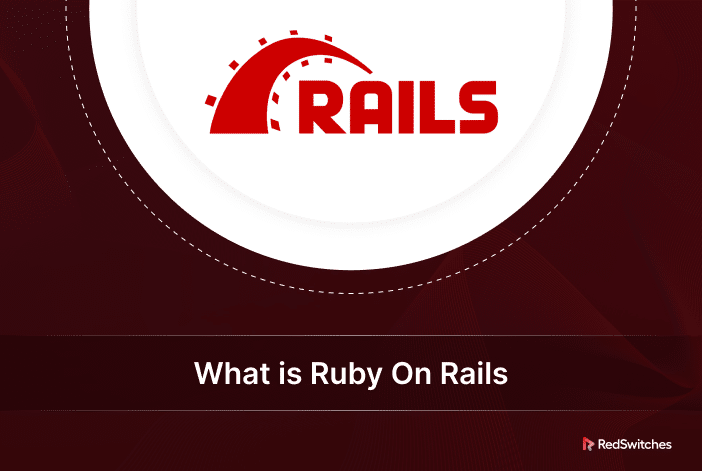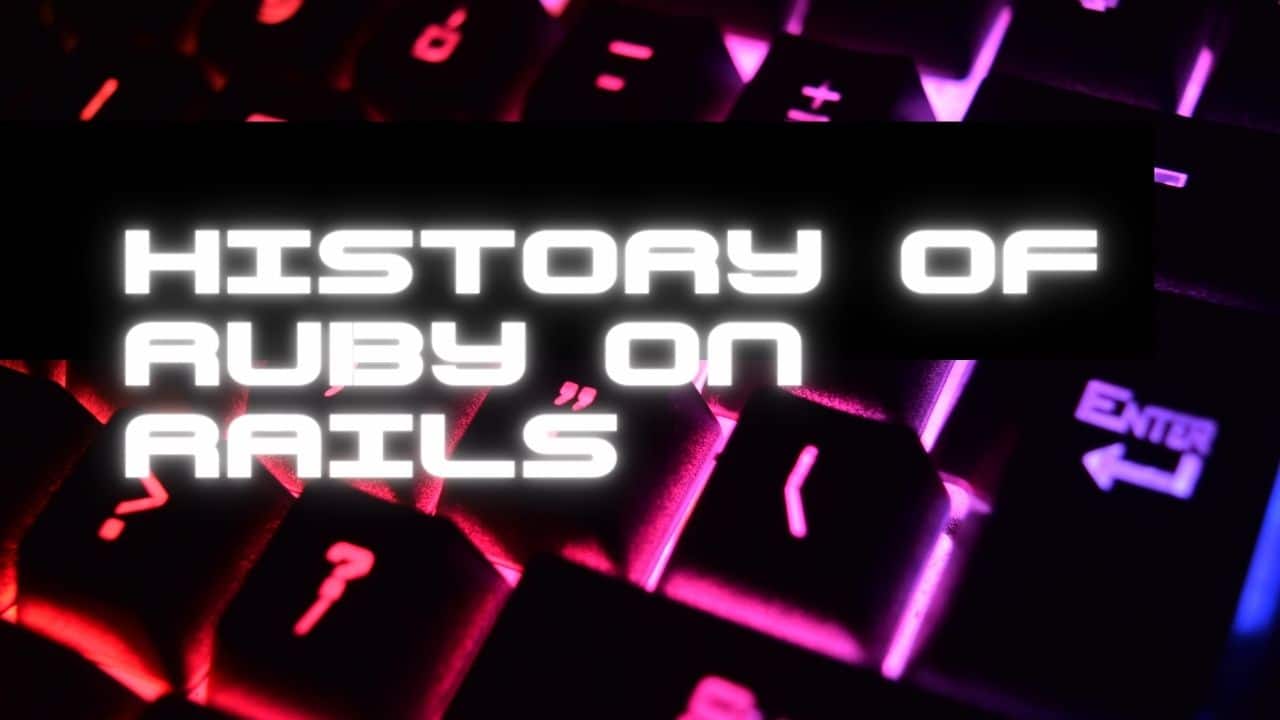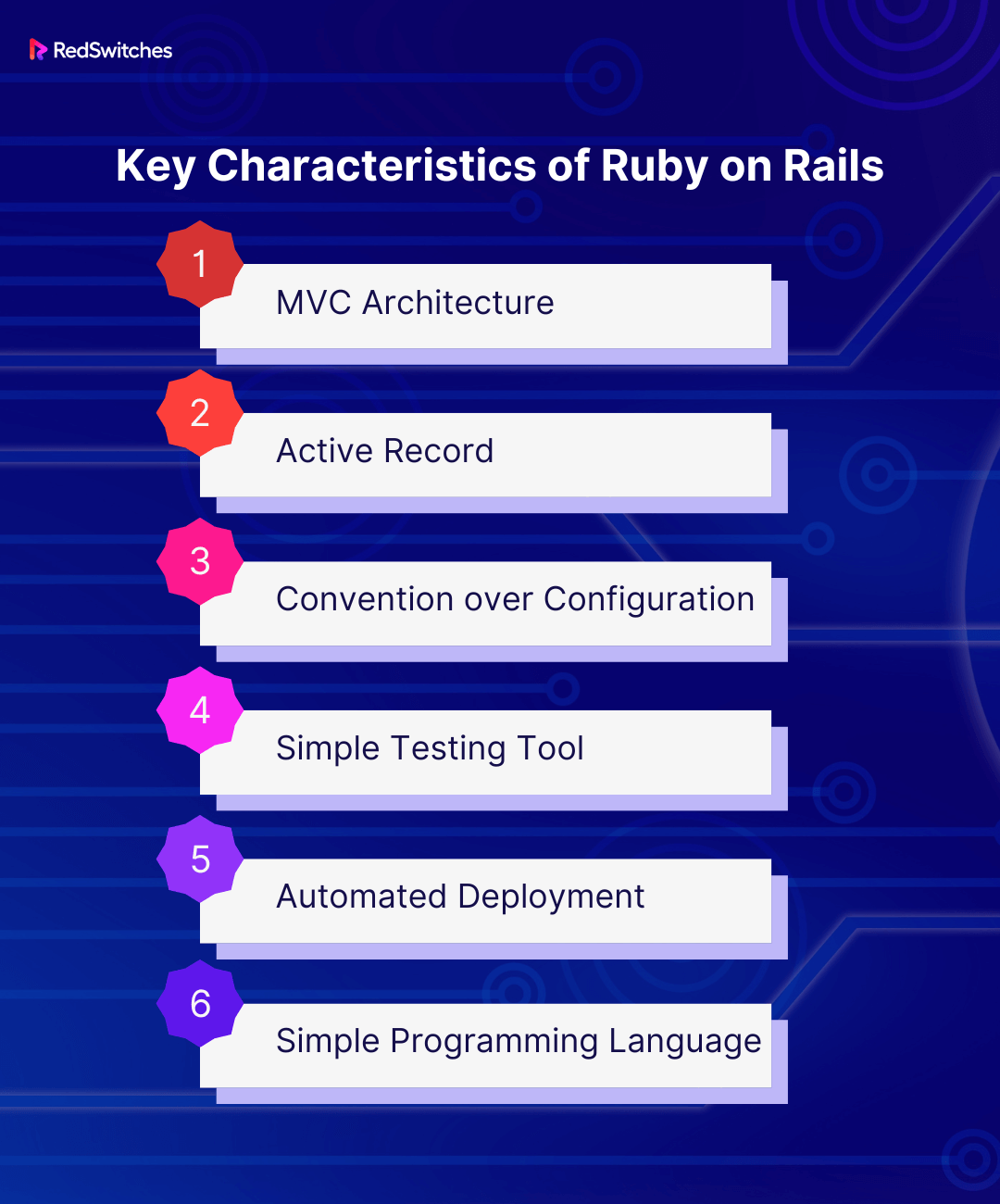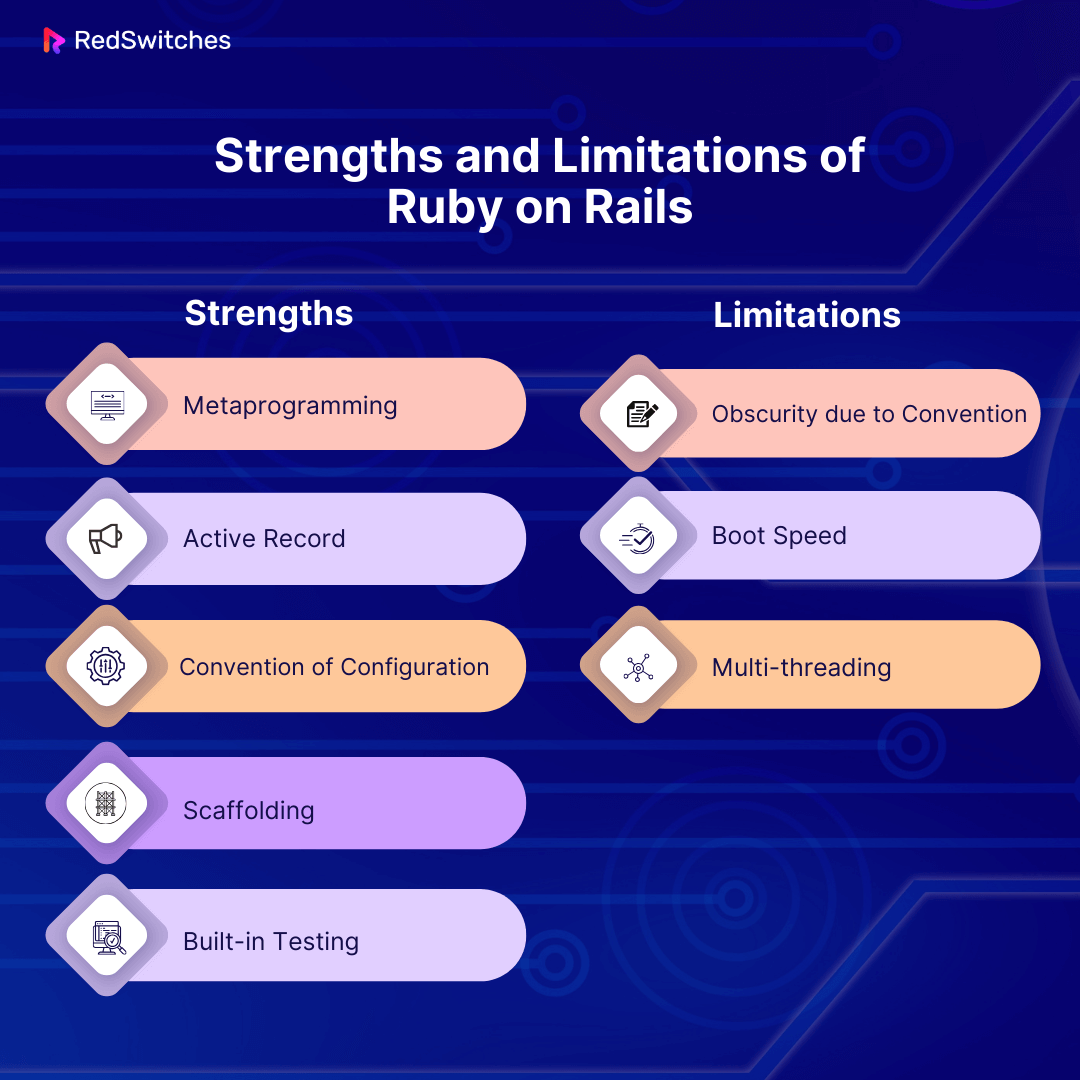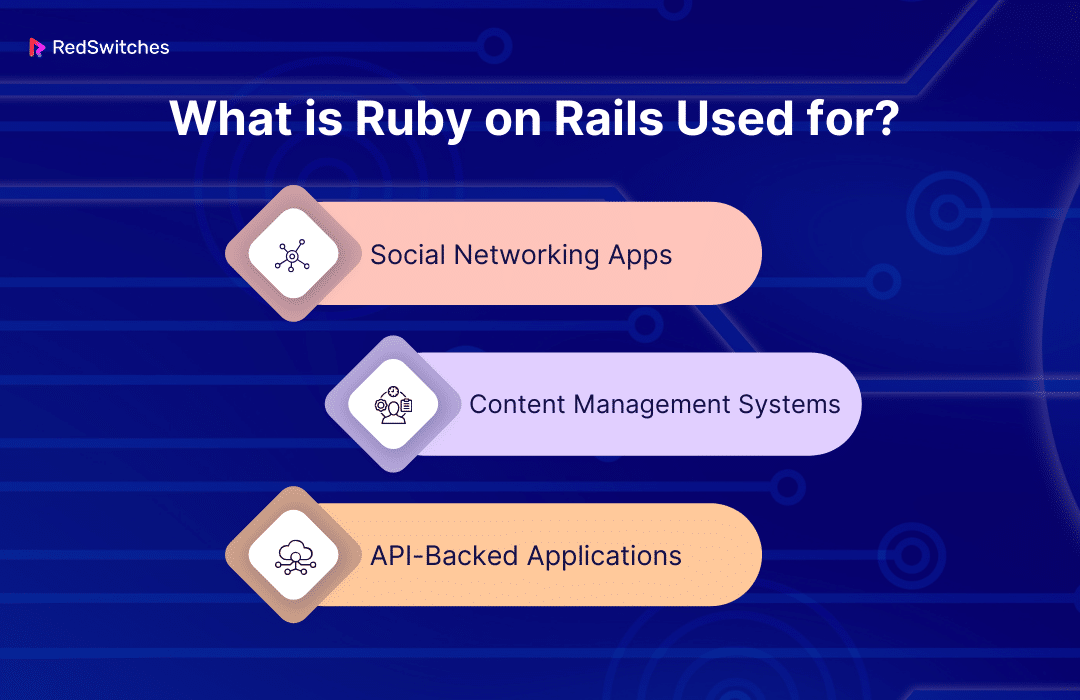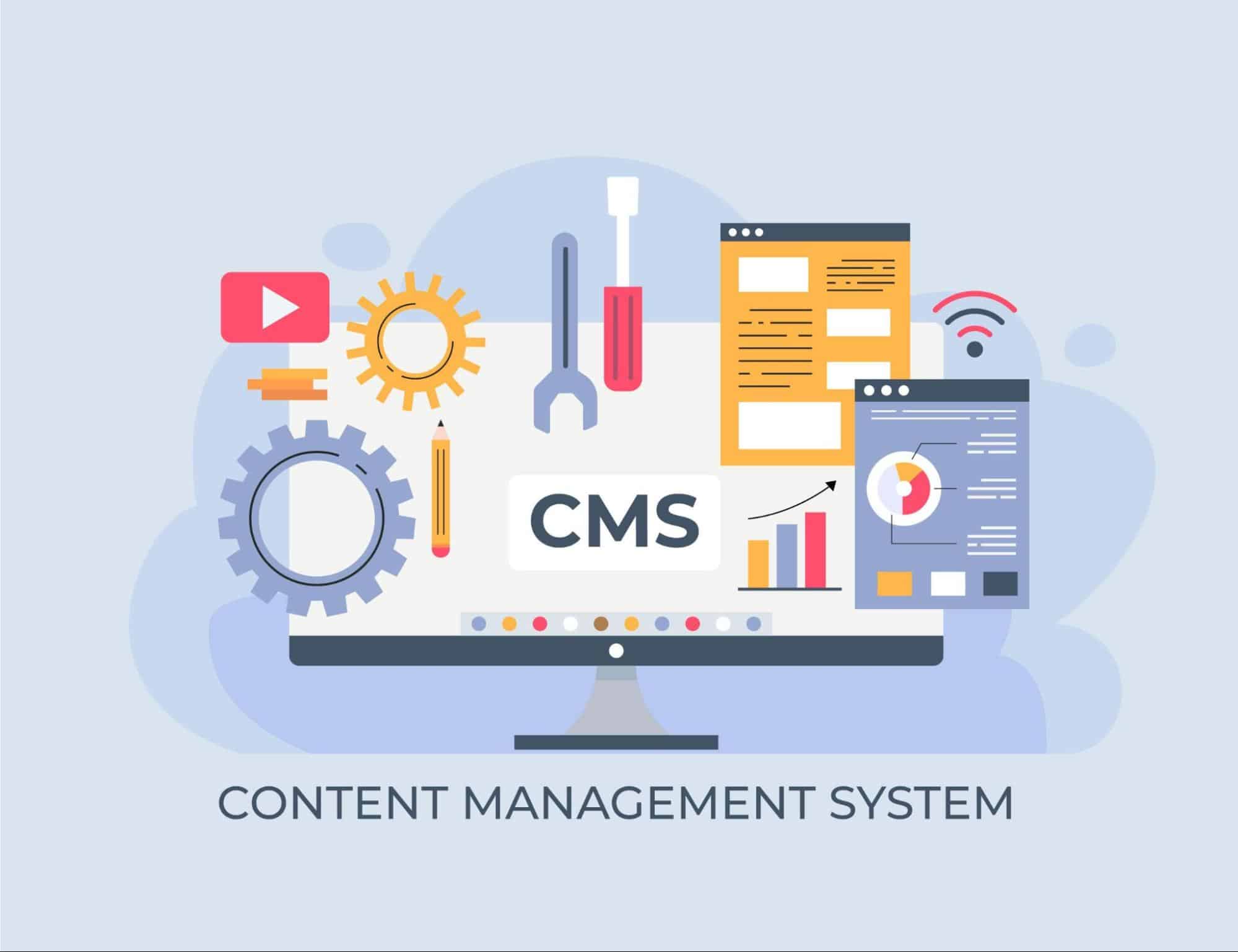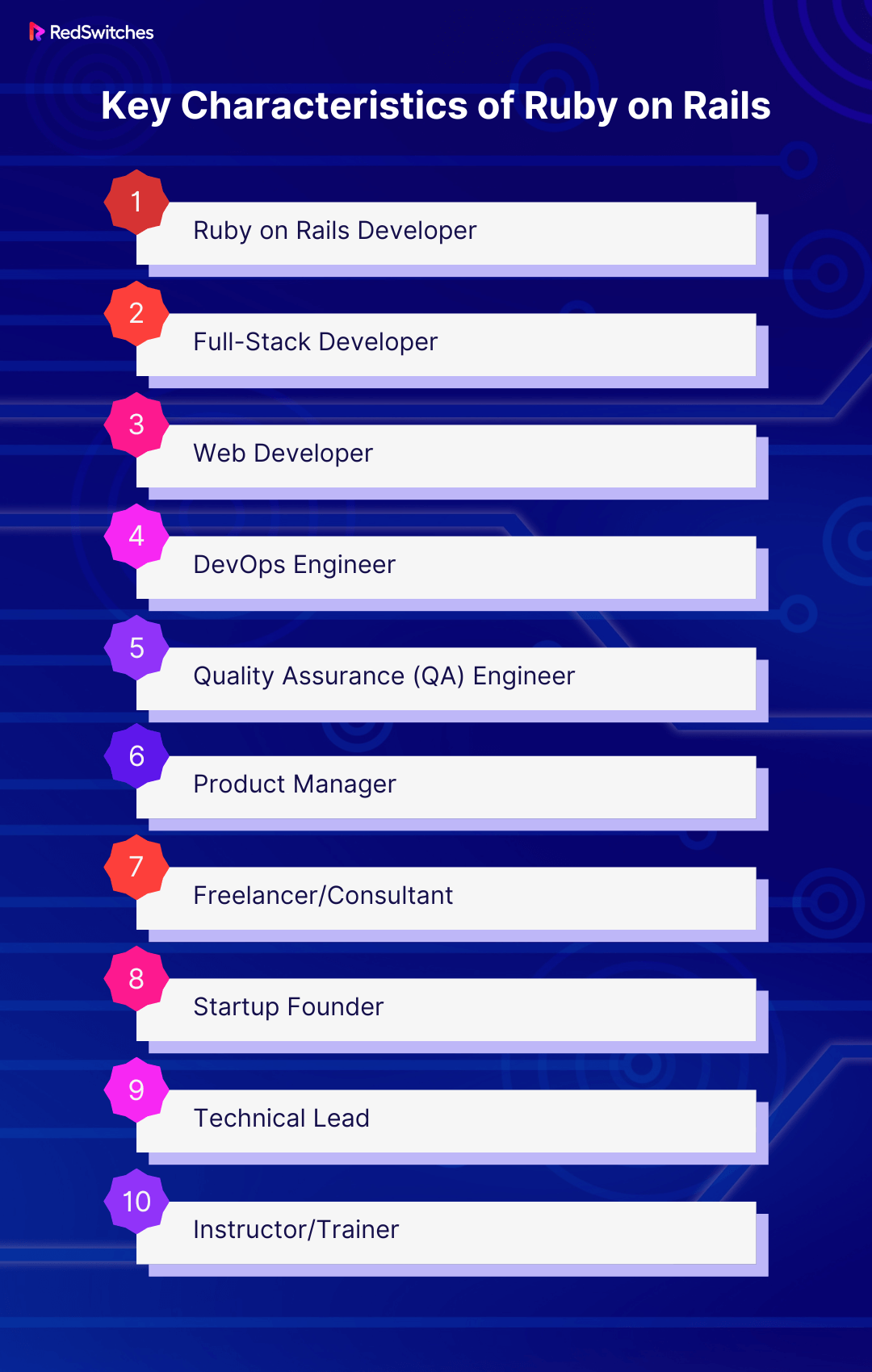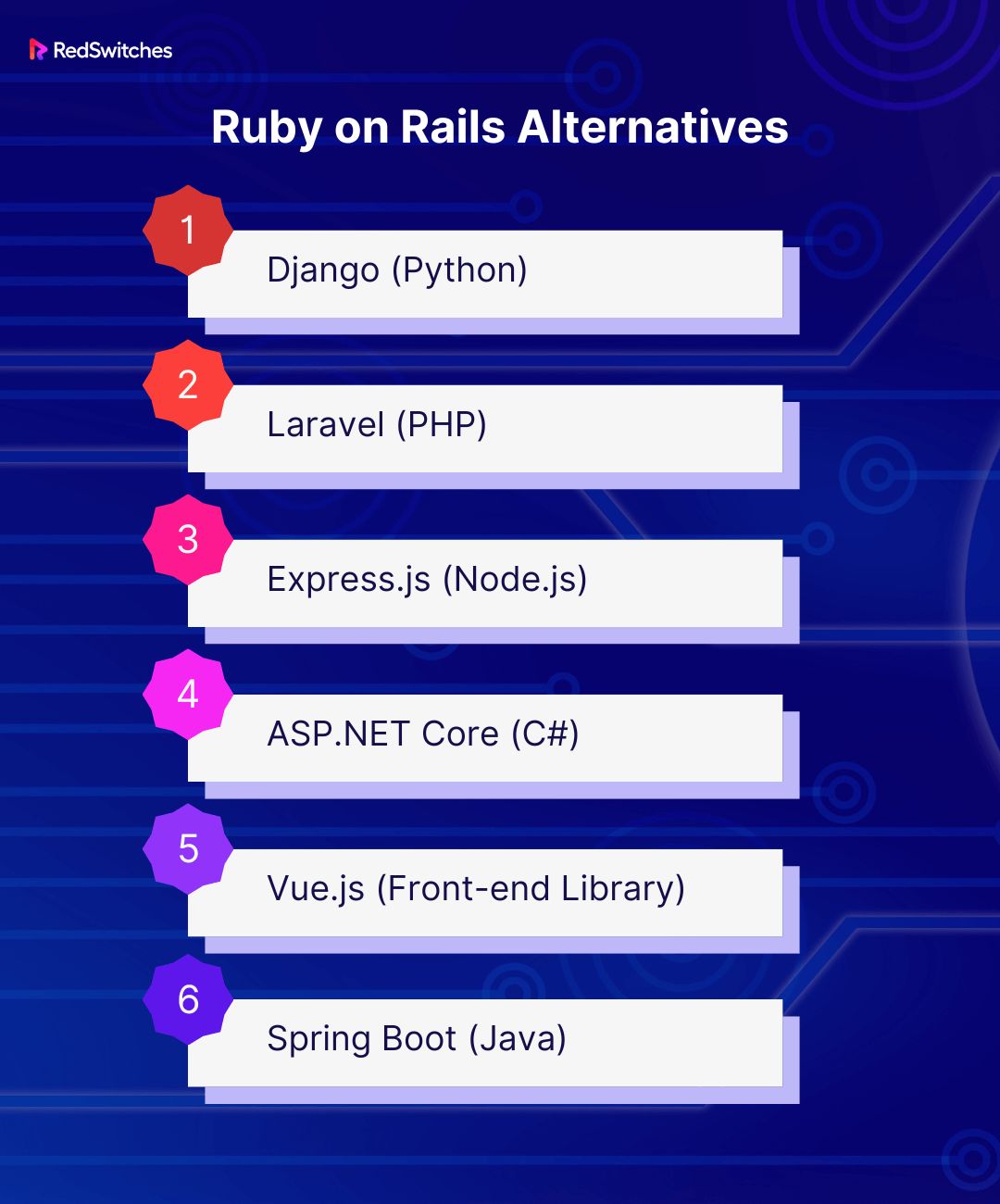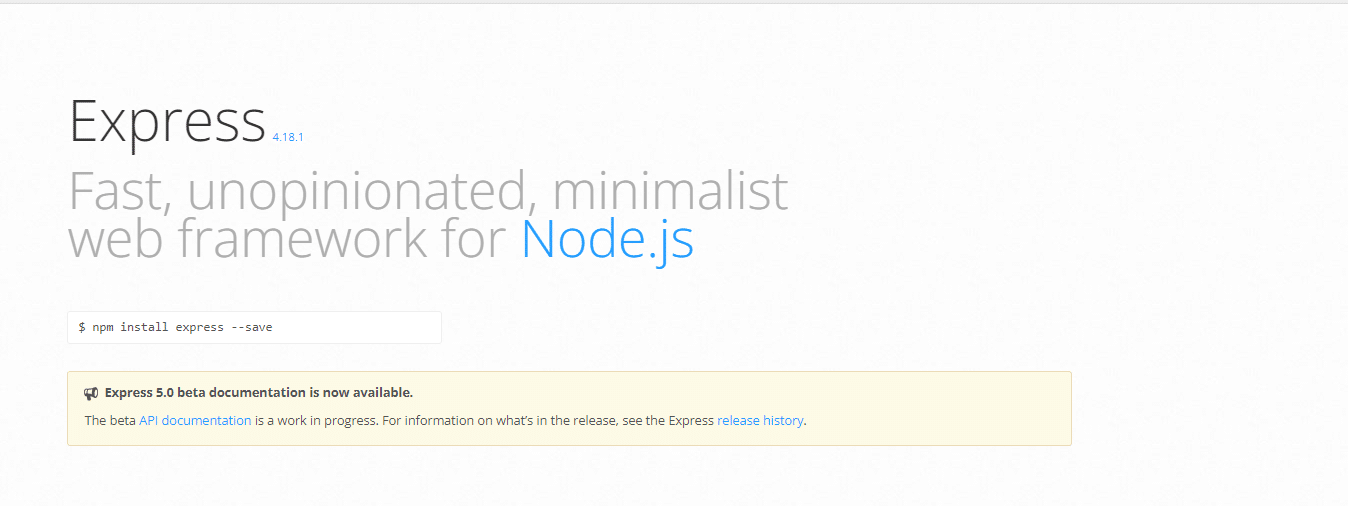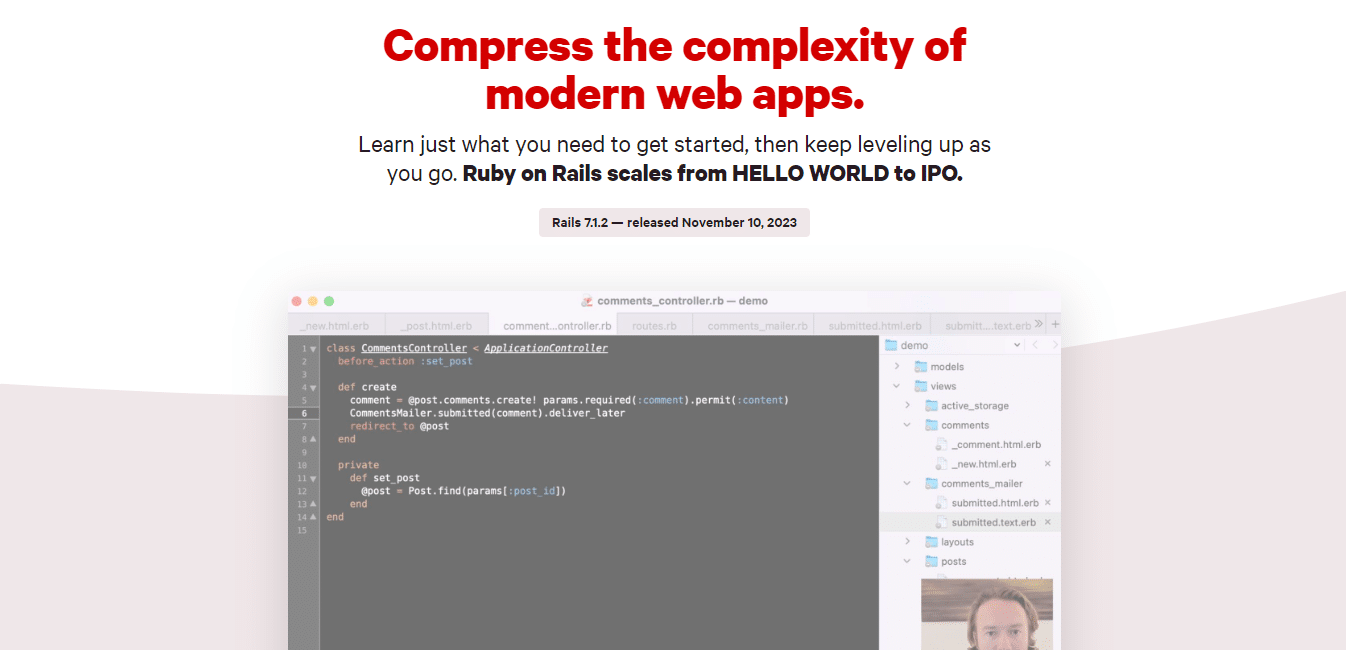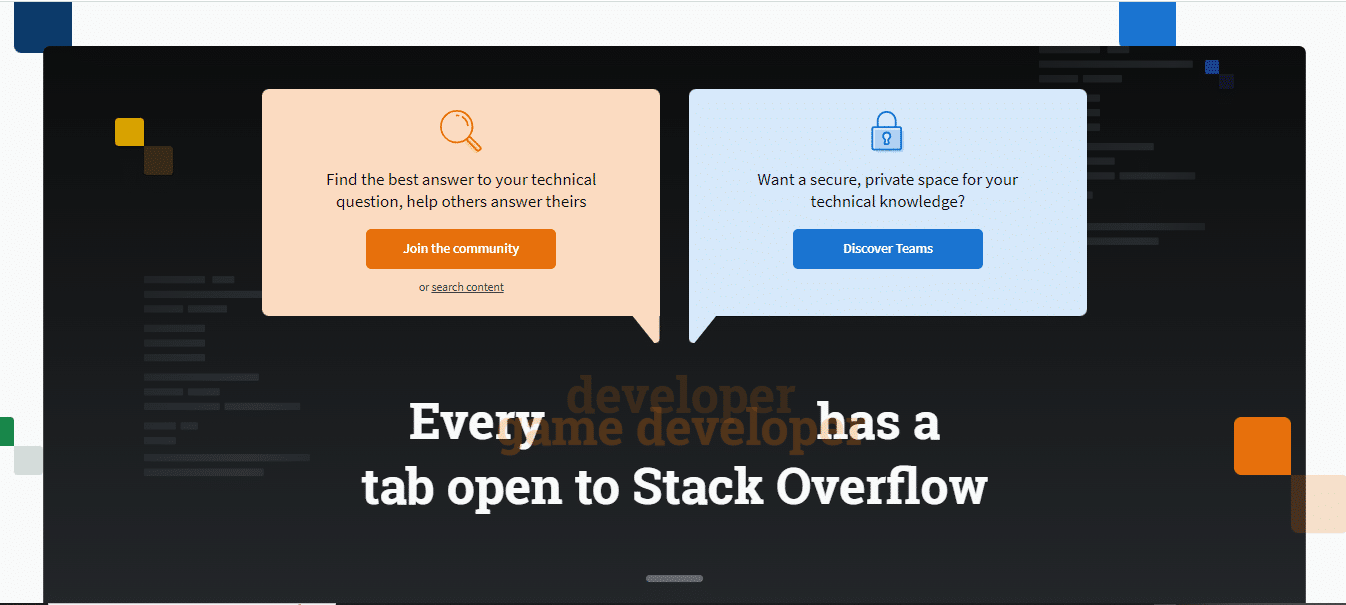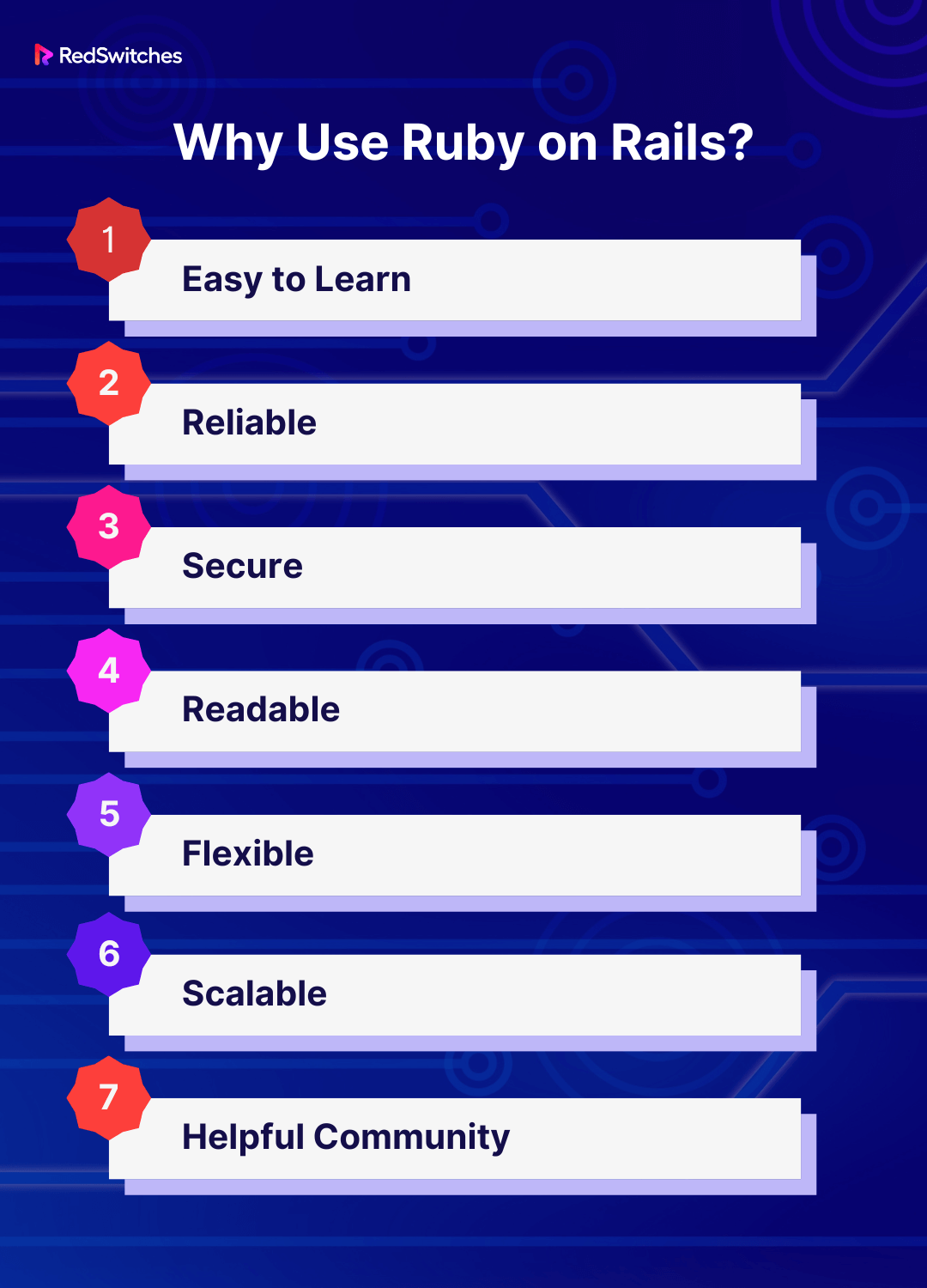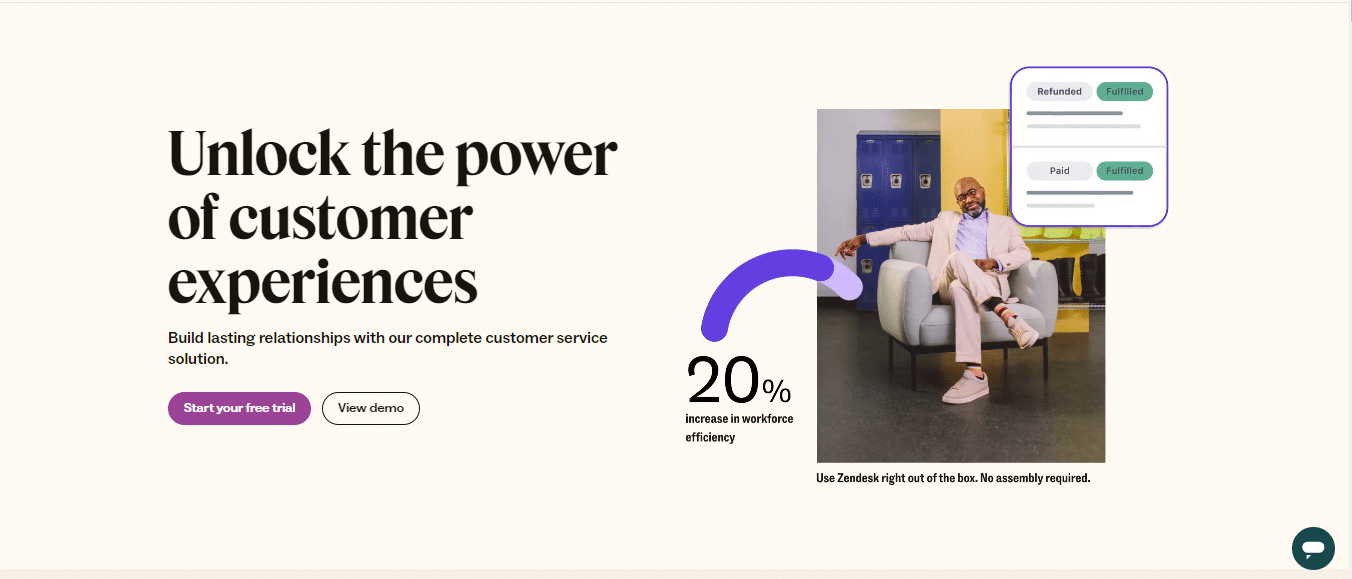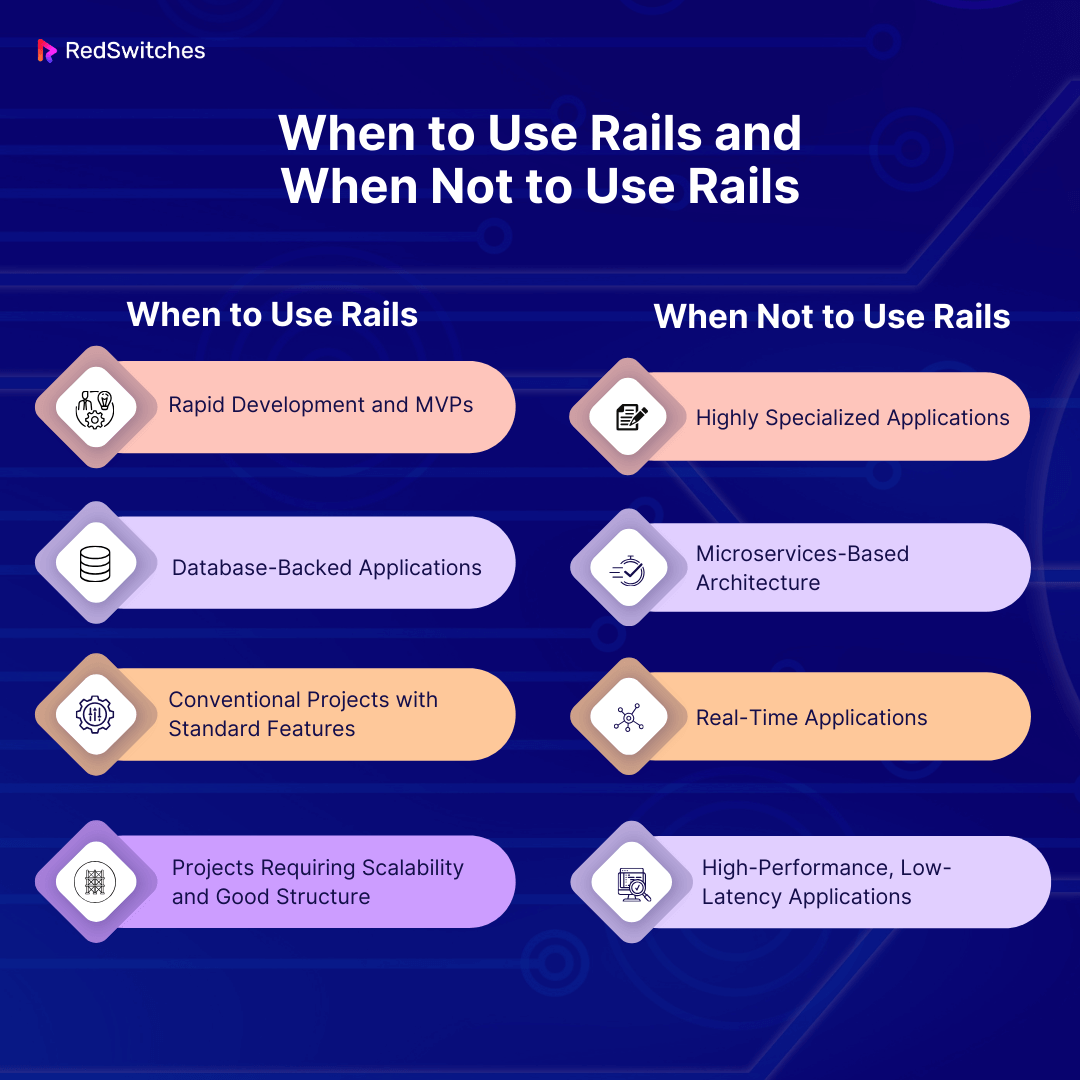Ruby on Rails, often called Rails, is a powerful and renowned web application framework that has shaped the landscape of modern web development. Currently, approximately 3,812,060 websites use Ruby on Rails.
With several web application frameworks available, deciding whether Ruby on Rails is the right framework for you can be difficult. This requires you to develop an in-depth understanding of ‘what is Ruby on Rails,’ its features, applications, etc.
In this comprehensive guide, we discuss what is Ruby on Rails and explore its key characteristics, strengths, and limitations to help you make an informed decision.
Before diving into the intricacies of Ruby and Rails, let’s go over what is Ruby and what is Rails.
Table Of Contents
- What is Ruby?
- What is Ruby on Rails?
- What is Ruby on Rails Used for?
- Jobs Related to Ruby on Rails
- Ruby on Rails Alternatives
- Is Ruby on Rails Dead?
- Ruby on Rails Tutorial
- Ways to Learn Ruby on Rails
- Why Use Ruby on Rails?
- Web Apps Built with Ruby on Rails
- When to Use Rails and When Not to Use Rails
- Future of Ruby on Rails
- Ruby’s Endurance in the Competitive Landscape
- Rails: Keeping Pace with Web Development Evolution
- Targeting Performance Improvements
- Community and Ecosystem: A Pillar of Strength
- Integration with Modern Front-End Technologies
- Adapting to API-Driven and Microservices Trends
- Educational Focus: Securing Future Growth
- Final Thoughts – What is Ruby on Rails
- FAQs
What is Ruby?
Before looking at ‘what is Ruby on Rails,’ it is important to discuss what is Ruby.
Ruby is a high-level programming language known for its elegant and concise syntax. Created by Yukihiro Matsumoto (often called Matz) in the mid-1990s, Ruby was designed to make programming powerful and enjoyable for developers. It is often celebrated for its human-readable code and flexibility, allowing developers to write clean and efficient programs easily.
Ruby follows an object-oriented programming (OOP) paradigm and supports features like metaprogramming, enabling developers to modify and extend the language. Ruby’s versatility has made it popular for web development, scripting, automation, and more, and it serves as the foundation for the Ruby on Rails web framework, further enhancing its utility in building web applications.
Also Read: Web Server Vs Application Server: Understanding The Differences.
What is Ruby on Rails?
One common query most individuals newly introduced to the world of Ruby and Rails and web application frameworks ask is: What is Ruby on Rails?
So what is Ruby on Rails?
Ruby on Rails is a powerful and popular open-source web application framework written in the Ruby programming language. It was created by David Heinemeier Hansson in 2003 and slowly began to gain widespread recognition for its simplicity, elegance, and productivity-boosting features.
Ruby on Rails follows the Model-View-Controller (MVC) architectural pattern. This helps developers build web applications by separating them into three interconnected components: the Model (data and database), the View (user interface), and the Controller (logic and user input handling).
One of Ruby on Rails’s defining characteristics is its convention-over-configuration philosophy. This means that the framework enforces certain conventions, eliminating the need for developers to specify every detail. Instead, they can focus on writing clean and maintainable code.
History of Ruby on Rails
Credits: Made with Canva
Now that you know what is Ruby on Rails, let’s explore how this web development framework came about:
Birth of Ruby on Rails
The story began in the early 2000s when a Danish programmer named David Heinemeier Hansson was working on a project for the project management tool Basecamp. Frustrated with the complexity and verbosity of existing web development frameworks, he created a more elegant and productive alternative.
Ruby’s Influence
Hansson chose the Ruby programming language as the foundation for this new framework due to its clean and intuitive syntax. Ruby’s creator, Yukihiro Matsumoto, had designed the language to prioritize developer happiness and productivity, making it an ideal match for Hansson’s vision.
Rails Emerges
In 2004, David Heinemeier Hansson released the first version of Ruby on Rails, also known as Rails or RoR. Rails introduced a groundbreaking concept: the Model-View-Controller (MVC) architecture, which made it easier to develop and maintain web applications. This architectural pattern allowed for a clear separation of concerns, simplifying code organization and enhancing collaboration among developers.
Rapid Adoption
Ruby on Rails quickly gained traction in the web development community. Its simplicity, convention over configuration approach, and elegant code structure attracted developers looking for a more enjoyable and productive development experience. Popular web applications like Twitter, Airbnb, and GitHub have been built on Ruby on Rails, further solidifying its reputation.
Key Characteristics of Ruby on Rails
Below are a few key characteristics of Ruby on Rails that have contributed to its popularity in the web application framework community:
1. MVC Architecture
One of the most significant characteristics of Ruby on Rails is its adherence to the Model-View-Controller (MVC) architectural pattern. This separation of concerns allows developers to keep their application’s logic, presentation, and data management neatly organized.
The ‘Model’ represents the data and database interactions, the ‘View’ deals with the user interface and presentation, and the ‘Controller’ acts as the intermediary, handling user requests and managing the data flow between the Model and View. This clean separation makes code more maintainable and promotes scalability, a key advantage for complex web applications.
2. Active Record
Active Record is a prominent feature of Ruby on Rails that simplifies database operations. It provides an object-oriented interface to the database, allowing developers to work with database records using Ruby classes and methods. Developers can interact with data by defining models corresponding to database tables without manually writing complex SQL queries.
This abstraction simplifies database operations, reduces the risk of SQL injection, and enhances code readability. Active Record’s intuitive syntax streamlines database CRUD (Create, Read, Update, Delete) operations, making it a powerful tool for developers.
3. Convention over Configuration
Another distinguishing characteristic of Ruby on Rails is the principle of ‘Convention over Configuration’ (CoC). This philosophy streamlines development by providing sensible defaults and conventions that eliminate the need for extensive configuration.
Rails developers follow naming conventions for files, directories, and database tables, reducing the amount of code they need to write. CoC allows developers to focus on building unique features and functionality rather than spending time on repetitive configuration tasks. This approach boosts productivity and promotes consistency across Rails projects, making it easier for developers to collaborate and maintain code.
4. Simple Testing Tool
One of Ruby on Rails’s cornerstones is its built-in testing framework. Rails encourages Test-Driven Development (TDD) and provides developers with a simple and effective testing toolset. The framework’s integrated testing suite allows developers to write unit, functional, and integration tests easily.
This promotes code reliability and ensures that changes to the application don’t introduce unexpected bugs. The simplicity and robustness of Rails’ testing tools have contributed significantly to the framework’s popularity, as it empowers developers to create well-tested and dependable applications.
5. Automated Deployment
Deploying web applications can be complex and error-prone, but Ruby on Rails simplifies it considerably. Rails has many deployment options and tools that make the process smooth and automated. Popular tools like Capistrano allow for automated deployment scripts, making deploying applications to various hosting environments easy.
The Rails community has embraced containerization and orchestration technologies like Docker and Kubernetes, further streamlining deployment and scaling processes. With Rails, deploying and managing web applications becomes straightforward, saving developers valuable time and effort.
6. Simple Programming Language:
The Ruby programming language is at the core of Ruby on Rails. Ruby is celebrated for its simplicity and readability, making it an ideal choice for beginners and experienced developers. Ruby’s syntax is intuitive and elegant, emphasizing human-friendly code. This simplicity accelerates the development process and enhances collaboration among team members.
Ruby’s dynamic nature allows developers to express complex ideas with concise and natural language constructs. Rails developers can focus on solving business problems rather than wrestling with complex syntax, leading to more efficient and enjoyable development experiences.
Also Read: REST Vs GraphQL: A Comprehensive Guide To Use In 2023.
Credits: FreePik
Strengths of Ruby on Rails
Once you have understood what is Ruby on Rails, it is important to consider its strengths and weaknesses to determine whether it is a suitable web application framework for you:
Metaprogramming
One of the most notable strengths of Ruby, and by extension Ruby on Rails, is metaprogramming. Metaprogramming refers to writing code that writes other code, a powerful feature that Rails leverages extensively. This capability is intrinsic to Ruby, which Rails utilizes to simplify and automate many aspects of web application development.
It enables developers to write concise, expressive code that dynamically defines methods, classes, and modules. Metaprogramming in Rails boosts productivity and enhances the framework’s flexibility, allowing developers to create elegant, DRY (Don’t Repeat Yourself) code.
Active Record
Active Record, Rails’ Object-Relational Mapping (ORM) system, is another significant strength. Active Record simplifies the way developers interact with databases. It allows Ruby objects to be seamlessly mapped to database tables, abstracting complex SQL queries into simple, readable Ruby code.
This means developers can perform database operations without writing raw SQL, reducing the risk of SQL injection attacks. Active Record also supports a variety of database operations, including transactions, associations, validations, and migrations, making it a robust and secure tool for database management in web applications.
Convention of Configuration
Rails’ ‘Convention over Configuration’ philosophy sets it apart from other web frameworks. This principle means that Rails comes with a set of conventions that, when followed, reduce the need for configuring every aspect of the application.
It assumes sensible defaults for what it needs to function, allowing developers to focus on the unique aspects of their application rather than on boilerplate code. This approach significantly accelerates development, minimizing the decisions developers have to make, leading to faster project kickoffs and fewer bugs.
Scaffolding
Scaffolding in Rails refers to the automatic generation of a set of models, views, and controllers, which form the basic structure of a web application. This feature is particularly useful in the early stages of development, as it provides a quick and easy way to get a working prototype up and running.
Scaffolding also helps new developers understand the MVC (Model-View-Controller) architecture. It generates a clear, consistent, and functional example of how components interact in a Rails application.
Built-in Testing
Testing is an integral part of any robust development process, and Rails excels in this area with its built-in testing framework. Rails encourage test-driven development (TDD), including a comprehensive suite of testing tools covering unit, functional, and integration tests.
The framework integrates seamlessly with various testing libraries and tools, making it easier for developers to write and run tests. This built-in testing support ensures Rails applications are more stable, maintainable, and less prone to bugs.
Also Read: Exploring InterWorx Vs CPanel: A Side-by-Side Comparison.
Limitations of Ruby on Rails
1. Obscurity due to Convention
Ruby on Rails follows the principle of ‘Convention over Configuration’ (CoC), which enforces certain naming conventions and best practices. While this Convention can improve code consistency and collaboration, it can also be limiting for developers who prefer more flexibility and customization.
Solution: To overcome this limitation, developers can use Rails’ flexibility and override conventions when necessary. Developers can balance Convention and customization by understanding the framework deeply and knowing when to deviate from conventions.
2. Boot Speed
One of the criticisms often directed at Ruby on Rails is its slower boot speed compared to some other frameworks. A Rails application’s initialization process can be relatively slow, affecting development speed and server responsiveness.
Solution: To mitigate boot speed issues, developers can use techniques like code splitting, caching, and optimizing database queries. Tools like Spring and Bootsnap can also help improve Rails’ boot time.
3. Multi-threading
Ruby on Rails has historically faced challenges with multi-threading due to its Global Interpreter Lock (GIL). The GIL restricts multiple threads from executing Ruby code in parallel, limiting the benefits of multi-threading in certain scenarios.
Solution: To circumvent this limitation, developers can use other concurrency models like multi-processing or external services for parallel processing tasks. Alternatively, they can use JRuby, which runs on the Java Virtual Machine (JVM) and does not have a GIL limitation.
Table 1:
| Strengths | Limitations |
| Metaprogramming | Obscurity due to Convention |
| Active Record | Boot Speed |
| Convention of Configuration | Multi-threading |
| Scaffolding | |
| Built-in Testing |
What is Ruby on Rails Used for?
What is Ruby on Rails used for is yet another common query asked by individuals new to the world of web application frameworks. Let’s look at a few common applications of Ruby on Rails:
Social Networking Apps
Ruby on Rails has become a go-to choice for developing social networking applications. Here’s why:
- Rapid Development: Rails follows the ‘Convention over Configuration principle,’ which assumes what every developer needs to get started. This approach dramatically accelerates the development process, allowing developers to focus more on unique aspects rather than basic setups.
- Built-in Modules: Rails has several built-in modules and gems (Ruby packages) that are tailor-made for social networking features. For instance, Devise for authentication or CarrierWave for file uploads makes incorporating essential social networking functionalities easier.
- Scalability: While Rails has faced some criticism over scalability, many successful social platforms, including Twitter in its early days, were built using Rails. With the right architectural decisions, Rails applications can scale effectively to handle many users and interactions.
- Community Support: Ruby on Rails has a strong and active community. This community support means better documentation, many tutorials, and easy access to solutions for everyday problems, which is invaluable in social networking app development.
Content Management Systems
Credits: FreePik
Regarding building content management systems (CMS), Ruby on Rails offers several advantages:
- Flexible Content Management: Rails allows for creating customized content management systems. Unlike pre-built solutions, a Rails-based CMS can be tailored to specific requirements and provide the desired features and user interface.
- Ease of Integration: Rails makes integrating with other services and tools easy, which is often essential in a CMS. For instance, integrating with third-party applications for analytics, SEO tools, or payment gateways is more straightforward with Rails.
- Security: Security is a critical aspect of CMS, and Rails offers several built-in mechanisms to protect against common vulnerabilities like SQL injection, cross-site scripting, and cross-site request forgery.
- ActiveRecord: Rails’ ActiveRecord provides an intuitive and powerful way to handle database interactions, a core part of any CMS. It simplifies complex database operations, making managing and presenting content dynamically easier.
API-Backed Applications
Ruby on Rails offers several advantages in terms of the development of API-backed applications, including:
- Ideal for Robust Backend APIs: Rails has become a standard for applications that rely heavily on a solid backend API. Its streamlined approach to database operations and built-in support for web services make it particularly suitable in this area.
- Integrated Support for Web Services: Rails offers integrated solutions for developing web services, which is vital for API development. This reduces the need for additional tools or frameworks.
- ActiveRecord for Database Management: Rails uses ActiveRecord, an ORM (Object-Relational Mapping) tool, which simplifies interactions with the database. This mainly benefits API development, where database operations are frequent and complex.
- Convention-based Routing: Rails’ convention-based approach to routing makes it easier to define and manage the URLs and endpoints for an API, streamlining the development process.
Also Read: Web Server Vs Application Server: Understanding The Differences.
What Jobs Do You Need to Know Ruby on Rails for?
The answer to what jobs require you to know Ruby on Rails lies in understanding ‘what is Ruby on Rails programming language used for.’ Below is a list of diverse job roles that often require an understanding of ‘what is Ruby on Rails’:
Ruby on Rails Developer
Ruby on Rails developers are at the forefront of the list of people who must know ‘what is Ruby on Rails.’ These professionals specialize in crafting web applications using the Rails framework. Their duties encompass designing, coding, meticulously testing, and maintaining web applications. They’re responsible for ensuring these applications align with client requirements and are highly scalable.
Full-Stack Developer
Full-stack developers are renowned for their broad expertise, seamlessly blending front-end and back-end development skills. With a deep understanding of what is Ruby on Rails for robust back-end functionality and a proficiency in JavaScript, HTML, and CSS for dynamic front-end design, they are adept at creating comprehensive, integrated solutions for multifaceted projects.
Web Developer
Credits: Unsplash
Companies seek web developers well-versed in understanding ‘what is Ruby on Rails’ to construct and manage web applications. These developers are tasked with creating intuitive user interfaces, seamlessly integrating databases, and meticulously ensuring websites’ overall functionality and performance.
DevOps engineers play a pivotal role in the software development pipeline. They have a good knowledge of ‘what is Ruby on Rails’ and skillfully employ tools like Docker and Kubernetes to orchestrate the deployment and smooth operation of Ruby on Rails applications in diverse production environments.
Quality Assurance (QA) Engineer
QA engineers are the gatekeepers of application reliability. Those with an understanding of ‘what is Ruby on Rails’ can craft automated test suites to systematically scrutinize web applications, identifying and promptly addressing any issues that may arise, ensuring the application’s unwavering reliability.
Product Manager
Product managers collaborate closely with development teams. An understanding of what is Ruby on Rails is invaluable for them. This proficiency enables them to communicate effectively with developers, prioritize tasks, and make informed decisions about the product’s features, functionality, and roadmap.
Freelancer/Consultant
Many seasoned Ruby on Rails experts choose the path of freelancing or consultancy. They leverage their knowledge of ‘what is Ruby on Rails’ to assist a diverse clientele, helping them develop, maintain, or enhance web applications.
Startup Founder
Aspiring entrepreneurs looking to launch tech startups can gain a significant advantage by acquiring expertise in what is Ruby on Rails and its workings. This proficiency allows them to rapidly and cost-effectively develop minimum viable products (MVPs), a critical step in attracting investors and early adopters.
Technical Lead
Experienced Ruby on Rails developers can become technical leads. In this role, they guide and mentor other developers, helping them understand what is Ruby on Rails, establish coding standards, foresee the completion of projects, and make pivotal architectural decisions that underpin the success of varying development projects.
Instructor/Trainer
Credits: Pexels
Professionals well-versed in ‘what is Ruby on Rails’ often transition into the role of an instructor or trainer. By sharing their wealth of knowledge, they empower aspiring developers through courses, workshops, or online tutorials and contribute to the growth and proficiency of the broader development community.
Now that you know the jobs that require knowledge of ‘what is Ruby on Rails,’ let’s discuss some alternatives for the web application framework.
Also Read: Exploring Web Application Security Best Practices For 2024.
Ruby on Rails Alternatives
Ruby on Rails has long been a favorite among web developers for its simplicity, convention over configuration philosophy, and rapid development capabilities. As technology evolves and diverse project requirements emerge, you must know alternatives that better suit your needs.
Below is a list of the top Ruby on Rails alternatives:
1. Django (Python)
Django, a Python-based framework, offers a compelling alternative to Ruby on Rails. Known for its simplicity and readability, Django follows the ‘batteries-included’ philosophy, providing a rich standard library that streamlines development.
It excels in building robust, scalable web applications. If you are comfortable with Python or appreciate its clean syntax, Django is a strong contender, particularly for applications that require strong security measures or involve data analysis.
2. Laravel (PHP)
Laravel is an excellent choice for PHP enthusiasts. It emphasizes elegant and expressive code, making it a top pick for web developers. With its expressive syntax and a rich set of tools, Laravel offers a comprehensive ecosystem for web development. It excels in building web applications and RESTful APIs, promoting clean, maintainable code.
3. Express.js (Node.js)
Credits: Express.js Website
JavaScript enthusiasts often turn to Express.js, a lightweight and flexible framework ideal for full-stack development. Leveraging Node.js, Express.js is known for its minimalist approach, making it popular for building real-time web applications and APIs. If you need a lightweight, minimalist framework for your project, Express.js is a strong contender.
4. ASP.NET Core (C#)
If you’re in the world of C#, ASP.NET Core is a robust alternative. C# developers appreciate its performance and security features. ASP.NET Core offers cross-platform development capabilities and is well-suited for building enterprise-level applications. It’s reliable for enterprises and developers seeking high-performance, secure, and scalable applications.
5. Vue.js (Front-end Library)
While not a full-stack framework like Ruby on Rails, Vue.js is worth considering as a front-end companion. This JavaScript-based library focuses on building interactive user interfaces. It’s lightweight, easy to integrate with various back-end technologies, and ideal for single-page applications (SPAs) and enhancing user experiences.
6. Spring Boot (Java)
Java enthusiasts and enterprises looking for a robust and scalable framework for complex web applications often turn to Spring Boot. Renowned for its enterprise-level capabilities, Spring Boot provides extensive support for building scalable, production-ready applications. Its highly modular and customizable nature makes it a reliable choice for Java-based projects.
Is Ruby on Rails Dead?
Whether Ruby on Rails (RoR) is dead is debated in the tech community. While RoR may not be as dominant as it once was, it is far from considered ‘dead.’ Below are some key points to consider:
- Active Community: Ruby on Rails still has a dedicated community of developers who continue contributing, maintaining, and updating the framework.
- Existing Projects: Many web applications and projects are built on Ruby on Rails. Because these applications require ongoing maintenance and development, RoR skills remain relevant.
- Learning Resources: There are numerous learning resources and tutorials available for Ruby on Rails, making it accessible to newcomers who want to learn the framework.
- Ruby Language: The programming language behind RoR remains popular and is used in various contexts beyond web development.
- Job Market: While the job market for Ruby on Rails may not be as extensive as for some other technologies, job opportunities remain available for RoR developers, especially in startups and companies with legacy applications.
- Niche Use Cases: Ruby on Rails can be an excellent choice for specific niche use cases and startups looking for rapid development.
Also Read: Cloud Computing Vs Web Based Applications – Everything You Need To Know.
Ruby on Rails Tutorial
Credits: Ruby on Rails Website
Below is a step-by-step tutorial of Ruby on Rails for those who have recently learned what is Ruby on Rails, and wish to understand its workings:
Setting Up the Environment
Setting up a proper development environment is essential before diving into the exciting world of Ruby on Rails. This process involves a few key steps to ensure everything runs smoothly when building your Rails applications.
Install Ruby
The first step is installing Ruby, as Rails is a Ruby framework. The version of Ruby you need may depend on the version of Rails you plan to use. It’s usually a good idea to install a Ruby version manager, such as rbenv or RVM, as these tools make it easy to install and switch between multiple Ruby versions. This is especially useful if you work on multiple Rails projects that require different Ruby versions.
- Ruby Version Manager: Install rbenv or RVM following their respective documentation.
- Ruby Installation: After setting up the version manager, install Ruby. The Rails official website recommends the latest Ruby version for the latest Rails version.
Install Rails
Once you have Ruby installed, you can install Rails. Rails is updated frequently, so install the version that fits your project requirements. Use the RubyGems package manager, which comes with Ruby, to install Rails.
- RubyGems: This is Ruby’s package manager, used to manage Ruby libraries (gems).
- Rails Installation: In your terminal, run gem install rails. This command installs Rails and its dependencies.
Database System
Rails supports several database systems like PostgreSQL, MySQL, and SQLite. For beginners, SQLite is recommended for its simplicity and ease of setup. It’s lightweight and typically used for development and testing in Rails.
- SQLite: It usually comes pre-installed with Rails. If not, you can easily install it through your operating system’s package manager.
Creating Your First Rails Application
Generate a New Application
Creating a new Rails application is straightforward. Open your terminal and run the command rails new myapp. This command does a lot:
- It creates a new directory named myapp with all the necessary files and directory structure for a Rails application.
- It creates a new git repository in the directory if you have git installed.
- It runs bundle install to install the Ruby gems your app needs.
Start the Rails Server
Navigate to your new application directory using cd myapp. Start the server by running rails server or rails s for short. This command fires up the Puma web server that comes with Rails.
Visit Your Application
Open a browser and go to http://localhost:3000. You should see the Rails welcome page, indicating that your application is running correctly.
Exploring the MVC Framework
Rails uses the MVC (Model-View-Controller) architecture, an organizational model that separates data access, business logic, and user interface.
Models
Models in Rails represent the application’s data and logic. They are tied closely to the database and are primarily responsible for interacting with it. Rails models use Active Record, which provides a rich API for interacting with the database without writing raw SQL.
Views
Views are the user interface of your application. In Rails, views are often HTML files with embedded Ruby code (ERB files). They display data to users and allow user interaction.
Controllers
Controllers are the orchestrators of the Rails application. They handle incoming web requests, gather data from models, and pass it to views for presentation.
Building a Simple Blog
Let’s create a simple blog to understand how Rails components work together.
Generate a Scaffold
Run rails generate scaffold Post title:string body:text. This command generates a full set of models, database migration, controllers, and views needed for a basic blog post functionality.
Migrate the Database
Run rails db:migrate to create the posts table in your database with title and body fields.
Start the Server and Explore
Restart the Rails server and navigate to http://localhost:3000/posts. You can now create, read, update, and delete blog posts.
Customizing Your Application
Rails offers numerous ways to customize your application, including routes, views, and assets.
Routes
Modify routes in config/routes.rb. This file defines the URL mappings to your application’s controllers.
Views
You can customize the appearance and layout of your application in the app/views directory by editing the ERB files.
Assets
Enhance your application’s front end by adding custom stylesheets, JavaScript files, and images in the app/assets directory.
Also Read 7 Features For Choosing The Right Hosting For Developers.
What Are Some Ways to Learn Ruby on Rails, and How Long Should You Expect It to Take?
Understanding what is Ruby on Rails and its workings can seem daunting to many, prompting them to ask what are some ways to learn Ruby on Rails and how long will it take. Let’s look at the answer below:
Understanding the Basics
Ruby Language
Before diving into Rails, learning what is Ruby on Rails is crucial. This includes familiarity with its syntax, object-oriented features, and commonly used data structures. Depending on your background, this can take a few weeks or months.
MVC Architecture
Understanding the MVC pattern on which Rails is built is essential. This architectural pattern separates an application into three main logical components: the model, the view, and the controller.
Learning Resources
Online Courses
Numerous online courses are available, ranging from beginner to advanced levels. Websites like Coursera, Udemy, and Codecademy offer comprehensive Rails courses that include both theoretical learning and practical exercises.
Books
Several excellent books teach Rails, like ‘Agile Web Development with Rails’ and ‘The Ruby on Rails Tutorial.’ These books are often updated to cover the latest version of Rails and provide a deep understanding of how to build Rails applications.
Tutorials and Documentation
Rails has extensive and well-written documentation. The official Rails guides are a great starting point. Also, many free tutorials that are project-based and can help you learn by building real-world applications are available online.
Practice by Building Applications
The best way to learn Rails is by building applications. Start with simple projects like a blog or a to-do list and gradually move to more complex applications. This practical experience is invaluable and will consolidate your learning.
Join the Community
Credits: Stack Overflow Website
Rails has a vibrant and supportive community. You can enhance your learning experience by participating in forums, attending meetups, or contributing to open-source Rails projects. Websites like Stack Overflow and GitHub are great places to interact with other Rails developers.
Time Commitment
The time it takes to learn Rails effectively depends on several factors, including your prior programming experience, the learning resources you use, and the amount of time you dedicate to learning and practice.
- Beginners: If you’re new to programming, expect to spend at least six months to a year becoming comfortable with Ruby and Rails. This includes learning Ruby, MVC concepts, and a few Rails applications.
- Intermediate Developers: If you have experience with other web frameworks or languages, you can pick up Rails in 3 to 6 months.
- Advanced Developers: For seasoned developers familiar with similar technologies, getting up to speed with Rails could take as little as 1 to 3 months.
Continual Learning
Technology evolves rapidly, and Rails is no exception. Keep yourself updated with the latest changes in the Rails ecosystem. Following Rails blogs, attending webinars, and participating in community discussions can help in this regard.
Also Read The Best Hosting For Startups That Are Scaling Up And Growing.
Why Use Ruby on Rails?
One commonly asked query after ‘what is Ruby on Rails’ is why use Ruby on Rails? Let’s explore the answer below:
Easy to Learn
One of the most appealing aspects of Rails is its simplicity and ease of learning, especially for those already familiar with Ruby, the language it’s built on. Rails follows the principle of ‘Convention over Configuration,’ which means that it makes assumptions about what you want to do and how you will do it, so you don’t have to specify every little detail.
This significantly reduces the amount of code you need to write and increases the development speed. This is a blessing for beginners as it allows them to quickly grasp the basics and start building functional web applications in no time.
Reliable
Rails embraces Test-Driven Development (TDD), an approach to software development in which tests are written before the actual code. In TDD, developers first define what the application should do through tests and only then write the code to pass these tests.
This methodology allows developers to rely on the framework for guidance and encourages a more thoughtful and deliberate design process, leading to more robust and well-architected systems. TDD in Rails helps catch issues early in the development cycle, reducing the cost and effort associated with fixing bugs in later stages.
Secure
Security is a paramount concern in web development, and Rails excels in this area. It offers built-in mechanisms to protect against common vulnerabilities like SQL injection, cross-site scripting, and cross-site request forgery (CSRF).
These features are enabled by default, ensuring that even less experienced developers create secure applications. The Rails community is vigilant about identifying and patching vulnerabilities, so security updates are regularly released and easy to implement.
Readable
Rails is built on Ruby, a language celebrated for its readability. This readability is a significant asset for maintaining and scaling web applications. Code that is easy to read and understand is easier to modify, debug, and update. This clarity benefits individual developers and facilitates smoother collaboration within teams, as the codebase is more accessible to all team members.
Flexible
Flexibility is another hallmark of Rails. While it provides structure through the MVC (Model-View-Controller) architecture, it also allows developers enough flexibility to tailor applications according to specific needs. Rails support many web applications, from small-scale solutions to large, complex systems. Its modularity and the vast ecosystem of ‘gems’ (libraries) enable developers to extend and customize their applications as needed.
Scalable
Credits: FreePik
Concerns about the scalability of Rails are often misplaced. While it’s true that Rails applications might require more resources compared to some other frameworks, properly optimized Rails applications can scale effectively to meet high demand. Many high-traffic platforms, such as Shopify and GitHub, are built with Rails, demonstrating its capability to handle large-scale operations.
Helpful Community
The Rails community is one of its strongest assets. It’s an actively engaged community that continually contributes to enhancing the framework. Newcomers find a wealth of resources, tutorials, and forums where they can seek help and advice. The community’s commitment to improvement and support makes Rails not just a framework but a vibrant ecosystem where developers can grow and thrive.
Web Apps Built with Ruby on Rails
Several renowned applications have been built with the Ruby on Rails web application framework. This further enhances its popularity, intriguing developers to learn about Ruby on Rails.
Below are some examples of web apps built with Ruby on Rails:
GitHub
GitHub stands as a testament to Ruby on Rails’ scalability and robustness. Launched in 2008, GitHub quickly became the world’s leading software development platform, where millions of developers collaborate.
Built with Rails, it demonstrates the framework’s ability to handle massive amounts of data and interactions seamlessly. The platform’s success underlines how Rails facilitates rapid development and easy management of complex codebases, making it an ideal choice for collaborative projects and large-scale applications.
Shopify
Shopify, an e-commerce giant, runs on Ruby on Rails. This platform enables businesses of all sizes to set up online stores easily. Shopify’s choice of Rails highlights the framework’s capacity for handling high traffic and complex transactional processes.
With Rails, Shopify offers a user-friendly interface and powerful features, supporting over a million businesses worldwide. The platform’s scalability and customization, powered by Rails, are pivotal in its dominance in the e-commerce sector.
Zendesk
Credits: Zendesk Website
Zendesk is another Rails success story. This customer service software and support ticketing system chose Rails for its clean, readable syntax and the framework’s emphasis on convention over configuration. Zendesk’s use of Rails underpins the framework’s ability to create applications that require reliability and a seamless user experience.
The platform serves thousands of businesses globally and attributes its smooth operation and scalability to the Rails framework.
Hulu
Hulu, a major player in the streaming service industry, uses Ruby on Rails for its website. Rails has allowed Hulu to create a flexible, responsive, high-performing web interface in the highly competitive streaming market.
This demonstrates Rails’ suitability for handling high bandwidth applications and its effectiveness in delivering dynamic content to a large audience without compromising performance.
Kickstarter
Kickstarter, the world’s largest funding platform for creative projects, is built with Ruby on Rails. This choice underscores Rails’ ability to support innovative, community-focused platforms.
Rails’ efficiency and developer-friendly environment have allowed Kickstarter to manage many user interactions and transactions, proving its capability in social-oriented and large-scale web applications.
Also Read: What Is Server Clustering & How Does It Work? + 3 Benefits.
When to Use Rails and When Not to Use Rails
When to Use Ruby on Rails
Rapid Development and MVPs
- Speed and Efficiency: Rails is well-known for its ability to speed up development. This makes it an excellent choice for startups and businesses looking to develop a Minimum Viable Product (MVP) quickly. Its extensive libraries and ‘convention over configuration’ approach allow developers to get a project up and running in a fraction of the time it might take with other frameworks.
Database-Backed Applications
- ORM and Migration Support: Rails comes with ActiveRecord, an Object-Relational Mapping (ORM) system that makes working with databases intuitive and efficient. This is ideal for applications that require robust database interactions.
Conventional Projects with Standard Features
- Built-In Solutions: Rails offers out-of-the-box solutions for many standard web application features, such as user authentication and session management. This makes it a good fit for projects that don’t require highly unconventional solutions where standard practices are applicable.
Projects Requiring Scalability and Good Structure
- Scalable and Structured: Rails’ MVC framework ensures that applications are well-structured, making them easier to scale and maintain in the long run.
When Not to Use Ruby on Rails
Highly Specialized Applications
- Custom Solutions: For projects that require highly specialized, non-standard features, Rails’s conventions might be more of a hindrance than a help. A more flexible framework, or even a microservices architecture, might be better suited in these cases.
Microservices-Based Architecture
- Large-Scale Systems: While Rails can support microservices architecture, it may not always be the best fit, especially for complex, large-scale systems where different application components might require different technologies.
Real-Time Applications
- Limited Real-Time Capabilities: Applications that require extensive real-time features, like messaging apps, may limit Rails’ capabilities. While solutions like ActionCable exist, other frameworks might offer more robust support for real-time features.
High-Performance, Low-Latency Applications
- Performance Intensive: Rails might not be optimal for applications with critical performance and low latency. In these scenarios, languages and frameworks that offer closer control over system resources might be preferable.
Table 2:
| When to Use Rails | When Not to Use Rails |
| Rapid Development and MVPs | Highly Specialized Applications |
| Database-Backed Applications | Microservices-Based Architecture |
| Conventional Projects with Standard Features | Real-Time Applications |
| Projects Requiring Scalability and Good Structure | High-Performance, Low-Latency Applications |
Also Read: How to Install Ruby on Ubuntu 22.04
Future of Ruby on Rails
Credits: FreePik
The future of Ruby on Rails is a topic of interest for many developers and organizations. Below are some key points to consider:
Ruby’s Endurance in the Competitive Landscape
Ruby, celebrated for its elegance and readability, has long held a place in the hearts of developers. Its role in powering prominent websites like Airbnb, GitHub, and Shopify highlights its impact. Despite stiff competition from languages like JavaScript (Node.js), Python, and Go, Ruby’s simplicity and the robustness of its Rails framework continue to ensure its relevance in various projects.
Rails: Keeping Pace with Web Development Evolution
Rails, the cornerstone of Ruby’s web development capabilities, has shown remarkable adaptability. Key introductions like Action Cable and Active Storage demonstrate Rails’ commitment to evolving alongside modern web needs. Rails 7 marks a notable evolution, adopting innovative approaches like Hotwire and further enhancing its HTML-over-the-wire capabilities.
Targeting Performance Improvements
Ruby and Rails have often faced criticism over performance issues. The ambitious Ruby 3×3 initiative, targeting a tripling of Ruby’s performance by version 3, signifies a strong commitment to enhancing its competitiveness. This effort includes a focus on concurrent programming and JIT (Just-In-Time) compilation, underscoring a proactive approach to optimization.
Community and Ecosystem: A Pillar of Strength
The Ruby on Rails ecosystem, enriched with many gems (libraries), is a testament to its vibrant community. These libraries streamline development, making it faster and more efficient. The community’s active contribution to and updating the language and framework ensures their relevance and modernity.
Integration with Modern Front-End Technologies
Rails has adeptly embraced modern front-end technologies. In response to the popularity of frameworks like React, Vue.js, and Angular, Rails has evolved, particularly with its API mode, enabling it to function seamlessly as a backend for JavaScript-driven front-end architectures.
Adapting to API-Driven and Microservices Trends
The shift towards microservices and API-driven development is a trend that Rails aligns with well. Improvements in Rails 7, especially in its API mode, highlight its suitability as a robust backend solution for microservices architectures and single-page applications (SPAs).
Educational Focus: Securing Future Growth
Education and training significantly influence Ruby’s and Rails’ continued growth and adaptation. The availability of learning resources, comprehensive tutorials, and robust community support are crucial in attracting and helping new developers learn ‘what is Ruby on Rails’ and how it works. This has helped secure the future of both the language and the framework.
Final Thoughts – What is Ruby on Rails
Ruby on Rails is a powerful, flexible, and efficient web development framework. Its MVC architecture, ease of use, and the support of an active community make it an excellent choice for both beginners and experienced developers.
While it has some limitations, like boot speed and multi-threading challenges, the benefits, including metaprogramming capabilities, active record, and built-in testing features, often outweigh these concerns.
Whether starting a new project or scaling an existing one, Ruby on Rails offers a streamlined, secure, and scalable solution. RedSwitches provides the perfect platform for those needing reliable hosting services to deploy and manage Ruby on Rails applications effectively.
With RedSwitches Dedicated Servers, you get the support and resources needed to leverage Ruby on Rails for your web development needs. If you have any further questions about ‘what is Ruby on Rails,’ or want to learn more about our services, contact us today.
FAQs
Q. What is Ruby on Rails?
Ruby on Rails, often simply referred to as Rails, is an open-source web application framework written in Ruby. It is designed to make programming web applications easier by making assumptions about what every developer needs to get started.
Q. What is Ruby on Rails Used for?
Ruby on Rails, often referred to as Rails, is a server-side web application framework used for building efficient, scalable, and easy-to-maintain web applications. It’s favored for its ‘convention over configuration’ philosophy, making it a go-to choice for rapid development.
Q. What is Ruby Used for?
Ruby refers to an open-source programming language that emphasizes simplicity and productivity. Its elegant syntax is natural to read and easy to write. Ruby can be used for various applications, from simple scripting to complex web applications, especially when combined with the Ruby on Rails framework.
Q. Is Ruby Better than Python?
The comparison of Ruby with Python depends on the context of use. While Ruby, particularly Ruby on Rails, is renowned for its ease in building web applications, Python is known for its versatility, especially in data science and machine learning. Each has its strengths, and the better choice depends on the specific requirements of a project.
Q. What is Ruby on Rails vs Java?
‘What is Ruby on Rails’ compared to Java? Ruby on Rails is a web framework built on Ruby, known for its rapid development capability. Java is a programming language for various applications, from mobile apps to enterprise-level systems. Java is known for its performance, scalability, and versatility across platforms.
Q. Should I Learn Java or Ruby?
Whether you learn Java or Ruby depends on your career goals and interests. Java is widely used in enterprise environments and offers a strong foundation for understanding object-oriented programming. Ruby, and by extension Ruby on Rails, is excellent for web development and offers a more straightforward syntax. Your choice should align with the projects and industries you aspire to work in.
Q. What are the advantages of using Ruby on Rails?
Ruby on Rails offers several advantages such as convention over configuration, time-saving because of ready-to-use modules, strong community support, and efficient development due to its clear and readable code.
Q. What are the disadvantages of Ruby on Rails?
Despite its many advantages, Ruby on Rails does have some disadvantages, such as slower performance compared to some other web frameworks, a steep learning curve for beginners, and limitations in customization due to its strong conventions.
Q. What is the architecture of Ruby on Rails?
Ruby on Rails follows the Model-View-Controller (MVC) architecture, where the model represents the data, the view is responsible for the user interface, and the controller handles the communication between the model and the view.
Q. What makes Ruby on Rails a popular choice for web development?
The popularity of Ruby on Rails can be attributed to its productivity, developer-friendly nature, time-saving conventions, strong community support, and the ease of development it offers due to its clear and concise code structure.
Q. What programming language is Ruby on Rails written in?
Ruby on Rails is written in the Ruby programming language, which is known for its simplicity and readability, making it a popular choice among developers.
Q. What is the Rails framework in the context of Ruby on Rails?
The Rails framework, often simply referred to as Rails, is a collection of code libraries that make it easier for developers to build web applications. It provides ready-to-use modules and follows the “convention over configuration” doctrine.
Q. How is Ruby on Rails used in web application development?
Ruby on Rails is used to create web applications by providing a framework that simplifies and accelerates the development process. It allows developers to quickly build and deploy feature-rich applications.
Q. What is the introduction to Ruby on Rails for beginners?
For beginners, Ruby on Rails offers a comprehensive and developer-friendly framework for web application development. It emphasizes convention over configuration and provides tools and resources to kickstart the development process.
Q. Why is Ruby on Rails still relevant in 2024?
Ruby on Rails is still relevant in 2024 due to its strong community support, ongoing updates and improvements, time-saving conventions, and its proven track record of being a reliable and efficient web application framework.
